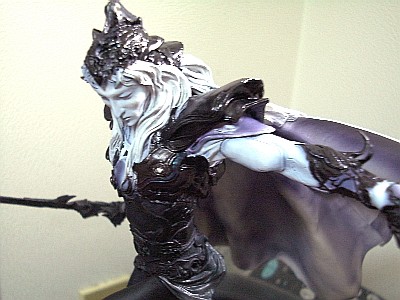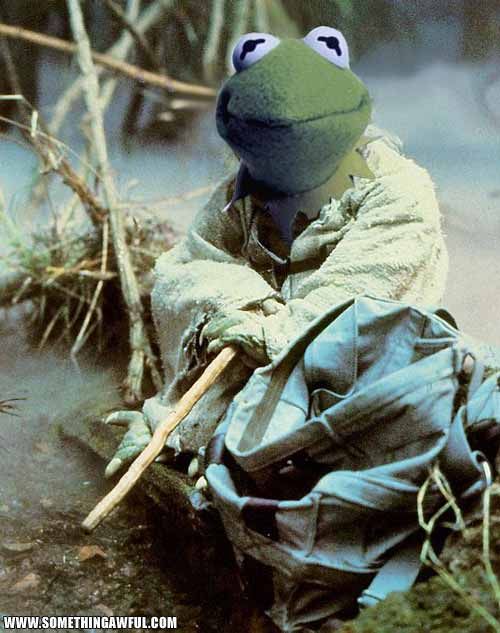The Shaman
[D&D Core Class]
The Shaman
Spirits, say shamans, are all around us: In the wind, the grave, and every drop of rain and spark of fire. Through magical chants and dances, shamans implore and even coerce spirits to do their bidding, whether in their healing allies, revealing the future, or destroying their enemies. Hailing from the same tribal societies as barbarians, shamans are often revered as witch doctors, medicine men, and mystics, serving their communities in ways that clerics, and even druids and wizards, serve their more civilized counterparts. But some shamans are powerful figures to be feared, wicked masters of voodoo, death, and the walking dead.
Shamans are common among tribal human, wild elf, and monstrous humanoid societies. Shamans need not worship a deity to receive their magic, but it is not uncommon, especially among orcs, for shamans to work in the name of a god, often one of death, healing, nature, or fire.

Shaman Prestige Classes: spiritbinder, voodoo queen.
Adaptation: The shaman serves the role of both arcane and divine spellcaster in barbaric and primitive societies.
Game Rule Information
Shamans (Shm) have the following game statistics.
Abilities: Charisma and Wisdom are key abilities for a shaman, influencing most of the shaman’s class skills and class features, from Heal to Spiritbind, and determining spellcasting. A high Intelligence provides bonus skill points that can be used in Crafting Totems, performing Tribal Dances, and overcoming the shaman’s Primitive nature. And high Dexterity and Constitution scores are valuable assets, allowing the shaman to avoid and withstand attacks.
Base Attack Bonus: Average (as a druid).
Hit Die: d6.
Saves: Good Will / Poor Fortitude and Reflex.
Class Skills: The shaman's class skills are Bluff (Cha), Concentration (Con), Craft (Int), Diplomacy (Cha), Handle Animal (Cha), Heal (Wis), Intimidate (Cha), Lucid Dreaming (Wis), Perform (Cha), Sense Motive (Wis), Spellcraft (Int), and Survival (Wis). Skill Points at Each Level: 6 + Intelligence modifier (x4 at 1st level).
Alignment: Any.
Starting Age: As a wizard.
Starting Gold: 4d4 x 10gp.
Favored Class: Shaman is favored class for half-elves and humans, and an additional or alternate favored class for half-orcs, at the DM's discretion.
Multiclassing: Characters that multiclass in to 1st-level shaman with levels in any other class except barbarian are not bound by the Primitive class feature, a by-product of a tribal upbringing. However, such characters do not receive any of the shaman’s weapon or armor proficiencies (but are still bound by shamanic armor restrictions). In addition, if a shaman reaches 2nd level with levels in any class other than barbarian or shaman, the shaman does not automatically gain Craft Totem but can acquire that feat separately.
Class Features
All of the following are class features of the shaman.
Weapons and Armor Proficiency: Shamans are proficient with the club, dagger, dart, handaxe, javelin, quarterstaff, shortbow, shortspear, sling, spear, and throwing axe. They are proficient with light armor but not with shields. Shamans cannot cast Shamanism spells when wearing metal armor or using metal shields. Their divine magic only works while wearing no armor or armor composed of leather, bone, hide, wood, or similar organic materials. Additionally, shamans cannot perform Tribal Dances if wearing armor heavier than Light. Spiritbind and other class features are unaffected by armor.
Omens
In the patterns of tossed bones, the flight of birds, the entrails of animals, and the positions of stars, the shaman can recognize and interpret omens – the cosmic clues and hidden signposts to the future. Once per day, he may perform an augury as a spell-like ability.
Primitive
The shaman hails from a primitive tribal culture without a written language. As such, he does not automatically know how to read and write. The shaman must spend 2 skill points to gain the ability to read and write all languages he is able to speak and to cast divine spells from scrolls normally.
More sophisticated magic items are somewhat foreign to the shaman as well, whose culture may have had little or no exposure to the likes of magic chainmail, magic rings, and magic rods. His caster level is considered -1 when meeting the pre-requisite for any Item Creation feat except Brew Potion and Craft Staff. In addition, the shaman must be able to read scrolls (as above) to qualify for the Scribe Scroll feat.
Characters that multiclass in to 1st-level shaman with levels in any other class except barbarian are not bound by the Primitive class feature, a by-product of a tribal upbringing. However, such characters do not receive any of the shaman’s weapon or armor proficiencies (but are still bound by shamanic armor restrictions) and does not automatically gain Craft Totem at 2nd level, but can acquire that ability as an Item Creation feat.
Shamanism
The shaman practices Shamanism, a very old form of divine magic dealing with spirits, nature, and healing. He casts divine spells without preparation, using the bard’s Spells Known and Spells Per Day progression and using his Charisma score to determine maximum spell level and Difficulty Class and his Wisdom score to determine bonus Spells Per Day. However, each day, the shaman selects his Spells Known for the day from the Shamanism spell list, and can select different spells each day, according to his anticipated needs:
Spirit Guide [1st/5th/10th/15th/20th level]
The shaman may call upon his spirit guide for advice and guidance. A spirit guide is a visual personification of nature that only the shaman can see. It always appears to him as a speaking, intelligent animal, such as a fox, bear, raven, or snake. The spirit guide has no material existence other than its image; it is not affected by magic or antimagic and cannot be attacked or attack, although Spirit Sight or true seeing and stronger divinations can reveal its appearance to others. The shaman can call on his spirit guide once per day plus once per day for every five levels.
Calling his spirit guide is a spell-like ritual requiring the shaman meditate for 1d4 minutes; when he opens his eyes, his spirit guide is before him. Each time the shaman calls his spirit guide, he may request a single task. In most cases, the spirit guide remains only long enough to perform the task and then disappears. The type of task that may be requested depends on the shaman's level:
Spirit guides have also been known to occasionally appear to shamans in their dreams with cryptic warnings, philosophical questions, or words of advice. These appearances are at the DM's discretion and do not count against the shaman's daily limit.
Craft Totem [2nd level]
The shaman enjoys his own cultural form of magic item creation, allowing him to fashion a small group of rustic magic objects without the costs normally associated with Item Creation. He gains the Craft Totem feat for free. Crafting a totem requires only skill, experience, time, and basic materials, but most totems hold their magic for only a short time, function only under certain conditions, and/or function only for the shaman himself or those he designates. Totems include animal tokens, burial ground markers, cave paintings, dreamcatchers, headdresses, medicine pouches, monkey paws, peace pipes, shrunken heads, spirit masks, totem poles, and voodoo dolls.
Spirit Sight [2nd level]
His vision extends into the spirit realm. Beginning at 2nd level, the shaman can see ethereal creatures as a supernatural ability. In addition, the shaman can also see any creature that he can Spiritbind if it is cloaked by spell-like or supernatural invisibility. For example, a shaman who binds Wind Spirits can see invisible stalkers, a binder of Nature Spirits can see invisible pixies, a binder of Fiends can see hellcats, etc.
Spiritbind [3rd/8th/13th/18th level]
The shaman can bind spirits to his will or make them tremble in his wake. He gains the supernatural ability to rebuke and command certain creatures as an evil cleric two levels lower affects undead. The shaman may so spiritbind a number of times per day equal to his Charisma modifier. At 3rd level and every five levels thereafter, he selects one of the following spirit types to affect:
* A good shaman can only rebuke (but not command) Spirits of the Dead; a nongood shaman can only rebuke (but not command) good-aligned Nature Spirits.
Shamans sometimes refer to spirits in terms more specific to their cultures: A desert-raised shaman, for example, may command Dune Spirits (Mountain Spirits) and Spirits of the Desert (Nature Spirits), while an islander shaman may refer to Volcano Spirits (Fire Spirits) and Spirits of the Sea (River Spirits). Unlike clerical turning, Spiritbind is unrelated to positive and negative energy and is not subject to effects or feats that target clerical turning.
Tribal Dance [4th/8th/12th/16th/20th level]
The shaman learns tribal dances that augment his magic. Performing the appropriate tribal dance immediately before casting certain spells imbues the spell cast with one of several often-metamagic effects.
Each dance can be performed as either a full-round action or as a 1-minute performance, the choice of which determining the number and potency of available effects. The shaman must select the desired effect and cast the spell to be affected within 1 round of completing the dance or any possible augmentation is lost and that daily use of the dance is wasted. While the effect of the dance is often metamagical in nature, it neither requires a higher spell slot or increase casting time to perform beyond the length of the dance. Likewise, tribal dances do not grant the shaman knowledge of any metamagic feat. If he is attacked while dancing, the shaman must make a Concentration check (DC damage dealt) or have the dance spoiled and that daily use lost. He can voluntarily end a dance after one round but short of the 1-minute mark and still receive the benefit of the full-round dance.
To learn his first dance, the shaman must have 4 ranks in Perform (Dance); each subsequent dance requires an additional 2 ranks in Perform (Dance), up to 12 ranks to learn all five dances. At the indicated levels (or as soon as he qualifies thereafter), he learns one dance. The shaman can perform a number of dances per day equal to the number of dances that he knows +1. The tribal dances are:
War Chant [6th level]
The shaman's sacred War Chant aids warriors in combat. Once per day for up to a number of rounds equal to his level, the shaman's chant grants all allies within 30 feet a +1 luck bonus to attack and damage rolls, even if they cannot hear him. Beginning the War Chant is a standard action that does not provoke an attack of opportunity; continuing it each round is a move action. While chanting, the shaman cannot cast spells with a Verbal component. This is a spell-like ability.
Spirit Touch [9th level]
Once per day, the shaman can affect ethereal creatures as if they were material. This manifests in one of two ways, chosen when Spirit Touch is employed: Any weapon in the shaman's hands or the missiles it fires (if applicable) carry the Ghost Touch effect for a number of rounds equal to 3 + any Wisdom bonus; or the shaman can cast one spell, of a spell level equal to 1 + any Wisdom bonus, and have that spell only affect ethereal creatures, as ifit had been cast on the Ethereal Plane. Initiating this supernatural ability is a move-equivalent action.
Spirit Walk [17th level]
After entering a trance, the shaman can free his soul from its corporeal cage. After 10 minutes of meditation, he can effect astral projection once per day, as the spell cast by a cleric of his caster level. This is a spell-like ability.
Epic Shaman: The epic-level shaman continues his Hit Die, skill point, Spiritbind, and Spirit Guide progressions. In addition, he receives bonus epic feats at 24rd level and every four levels thereafter (24th, 28th, 32nd, 36th, etc.).
Board Link: To feedback on this class posted on the Wizards of the Coast message boards. Originally posted in April, 2004.
Spirits, say shamans, are all around us: In the wind, the grave, and every drop of rain and spark of fire. Through magical chants and dances, shamans implore and even coerce spirits to do their bidding, whether in their healing allies, revealing the future, or destroying their enemies. Hailing from the same tribal societies as barbarians, shamans are often revered as witch doctors, medicine men, and mystics, serving their communities in ways that clerics, and even druids and wizards, serve their more civilized counterparts. But some shamans are powerful figures to be feared, wicked masters of voodoo, death, and the walking dead.
Shamans are common among tribal human, wild elf, and monstrous humanoid societies. Shamans need not worship a deity to receive their magic, but it is not uncommon, especially among orcs, for shamans to work in the name of a god, often one of death, healing, nature, or fire.

Shaman Prestige Classes: spiritbinder, voodoo queen.
Adaptation: The shaman serves the role of both arcane and divine spellcaster in barbaric and primitive societies.
Game Rule Information
Shamans (Shm) have the following game statistics.
Abilities: Charisma and Wisdom are key abilities for a shaman, influencing most of the shaman’s class skills and class features, from Heal to Spiritbind, and determining spellcasting. A high Intelligence provides bonus skill points that can be used in Crafting Totems, performing Tribal Dances, and overcoming the shaman’s Primitive nature. And high Dexterity and Constitution scores are valuable assets, allowing the shaman to avoid and withstand attacks.
Base Attack Bonus: Average (as a druid).
Hit Die: d6.
Saves: Good Will / Poor Fortitude and Reflex.
Class Skills: The shaman's class skills are Bluff (Cha), Concentration (Con), Craft (Int), Diplomacy (Cha), Handle Animal (Cha), Heal (Wis), Intimidate (Cha), Lucid Dreaming (Wis), Perform (Cha), Sense Motive (Wis), Spellcraft (Int), and Survival (Wis). Skill Points at Each Level: 6 + Intelligence modifier (x4 at 1st level).
Alignment: Any.
Starting Age: As a wizard.
Starting Gold: 4d4 x 10gp.
Favored Class: Shaman is favored class for half-elves and humans, and an additional or alternate favored class for half-orcs, at the DM's discretion.
Multiclassing: Characters that multiclass in to 1st-level shaman with levels in any other class except barbarian are not bound by the Primitive class feature, a by-product of a tribal upbringing. However, such characters do not receive any of the shaman’s weapon or armor proficiencies (but are still bound by shamanic armor restrictions). In addition, if a shaman reaches 2nd level with levels in any class other than barbarian or shaman, the shaman does not automatically gain Craft Totem but can acquire that feat separately.
Class Features
All of the following are class features of the shaman.
Weapons and Armor Proficiency: Shamans are proficient with the club, dagger, dart, handaxe, javelin, quarterstaff, shortbow, shortspear, sling, spear, and throwing axe. They are proficient with light armor but not with shields. Shamans cannot cast Shamanism spells when wearing metal armor or using metal shields. Their divine magic only works while wearing no armor or armor composed of leather, bone, hide, wood, or similar organic materials. Additionally, shamans cannot perform Tribal Dances if wearing armor heavier than Light. Spiritbind and other class features are unaffected by armor.
- Omens, Primitive, Shamanism, Spirit Guide [1/day]
- Craft Totem, Spirit Sight
- Spiritbind
- Tribal Dance
- Spirit Guide [2/day]
- War Chant
- Spiritbind, Tribal Dance
- Spirit Touch
- Spirit Guide [3/day]
- Tribal Dance
- Spiritbind
- Spirit Guide [4/day]
- Tribal Dance
- Spirit Walk
- Spiritbind
- Spirit Guide [5/day], Tribal Dance
Omens
In the patterns of tossed bones, the flight of birds, the entrails of animals, and the positions of stars, the shaman can recognize and interpret omens – the cosmic clues and hidden signposts to the future. Once per day, he may perform an augury as a spell-like ability.
Primitive
The shaman hails from a primitive tribal culture without a written language. As such, he does not automatically know how to read and write. The shaman must spend 2 skill points to gain the ability to read and write all languages he is able to speak and to cast divine spells from scrolls normally.
More sophisticated magic items are somewhat foreign to the shaman as well, whose culture may have had little or no exposure to the likes of magic chainmail, magic rings, and magic rods. His caster level is considered -1 when meeting the pre-requisite for any Item Creation feat except Brew Potion and Craft Staff. In addition, the shaman must be able to read scrolls (as above) to qualify for the Scribe Scroll feat.
Characters that multiclass in to 1st-level shaman with levels in any other class except barbarian are not bound by the Primitive class feature, a by-product of a tribal upbringing. However, such characters do not receive any of the shaman’s weapon or armor proficiencies (but are still bound by shamanic armor restrictions) and does not automatically gain Craft Totem at 2nd level, but can acquire that ability as an Item Creation feat.
Shamanism
The shaman practices Shamanism, a very old form of divine magic dealing with spirits, nature, and healing. He casts divine spells without preparation, using the bard’s Spells Known and Spells Per Day progression and using his Charisma score to determine maximum spell level and Difficulty Class and his Wisdom score to determine bonus Spells Per Day. However, each day, the shaman selects his Spells Known for the day from the Shamanism spell list, and can select different spells each day, according to his anticipated needs:
- 0 Level: big stick, create water, cure minor wounds, dancing lights, detect magic, detect poison, finger of flame, ghost sound, guidance, internal sundial, know direction, light, lullaby, mending, message, purify food and drink, resistance, summon tool, touch of fatigue
- 1st Level: animate corpse, arrowfire, bane, bless, burning hands, cause fear, charm animal, charm person, cure light wounds, detect animals and plants, detect evil, detect snares and pits, doom, endure elements, fury eyes, goodberry, greater create water, hide from animals, hide from undead, hypnotism, lesser bear's endurance, lesser bull's strength, lesser cat's grace, lesser eagle's splendor, lesser fox's cunning, lesser owl's wisdom, lesser physique, magic stone, magic weapon, mount, obscuring mist, produce flame, protection from evil, remove fear, shillelagh, sleep, summon nature's ally I
- 2nd Level: animal trance, bear's endurance, blindness/deafness, bull's strength, cat's grace, command undead, continual flame, cow's cunning, create bows and arrows, cure minor wounds: mass, cure moderate wounds, death knell, delay poison, eagle's splendor, enthrall, false life, fox's cunning, greater shillelagh, gust of wind, hold person, inflict minor wounds: mass, jellyfish's endurance, jinx, lemming's wisdom, lesser restoration, magic quiver, mouse's strength, owl's wisdom, physique, pig's splendor, protection from arrows, pyrotechnics, rage, scare, shriek, spectral hand, status, suggestion, summon nature's ally II, summon swarm, touch of idiocy, turtle's grace
- 3rd Level: animate dead, bestow curse, call lightning, contagion, create food and water, cure serious wounds, deep slumber, diminish plants, dire charge, dispel magic, fear, flame arrow, greater magic weapon, lesser geas, magic circle against evil, neutralize poison, phantom steed, plant growth, poison, polymorph (animal form), prayer, remove blindness/deafness, remove curse, remove disease, scrying, speak with animals, speak with dead, summon nature’s ally III
- 4th Level: age, blight, bloodcurdling scream, break enchantment, cudgel, discern lies, dominate person, hallucinatory terrain, greater bear's endurance, greater bull's strength, greater cat's grace, greater eagle's splendor, greater fox's cunning, greater owl's wisdom, greater physique, legend lore, Leomund’s secure shelter, minor creation, phantasmal killer, quench, reincarnate, restoration, speak with plants, summon nature’s ally IV, wall of fire, wizen
- 5th Level: baleful polymorph, bedevil, call lightning storm, clear sky, control winds, cure critical wounds, dispel evil, dream, fabricate, floramorphosis, greater jinx, insect plague, magic jar, mass cure light wounds, Mordenkainen’s faithful hound, nightmare, raise dead, stone tell, summon nature’s ally V, sunlight, true seeing, ursa minor, vision
- 6th Level: arrow of slaying, demonwrack, control weather, create undead (juju zombie), emotion, eyebite, finger of death, fire seeds, forbiddance, geas/quest, greater cudgel, greater dispel magic, heal, heroes' feast, Illiquin's dysmorphia, insanity, mass bear's endurance, mass bull's strength, mass cat's grace, mass cure moderate wounds, mass eagle's splendor, mass fox's cunning, mass hold person, mass owl's wisdom, mass physique, necromorphosis, olympian's physique, phantom ram, primitivity, project image, prophecy, senescence, sleep of ages, spirit bow, summon nature's ally VI, visage of horror, youth and beauty
- 1st Level: animate corpse, arrowfire, bane, bless, burning hands, cause fear, charm animal, charm person, cure light wounds, detect animals and plants, detect evil, detect snares and pits, doom, endure elements, fury eyes, goodberry, greater create water, hide from animals, hide from undead, hypnotism, lesser bear's endurance, lesser bull's strength, lesser cat's grace, lesser eagle's splendor, lesser fox's cunning, lesser owl's wisdom, lesser physique, magic stone, magic weapon, mount, obscuring mist, produce flame, protection from evil, remove fear, shillelagh, sleep, summon nature's ally I
Spirit Guide [1st/5th/10th/15th/20th level]
The shaman may call upon his spirit guide for advice and guidance. A spirit guide is a visual personification of nature that only the shaman can see. It always appears to him as a speaking, intelligent animal, such as a fox, bear, raven, or snake. The spirit guide has no material existence other than its image; it is not affected by magic or antimagic and cannot be attacked or attack, although Spirit Sight or true seeing and stronger divinations can reveal its appearance to others. The shaman can call on his spirit guide once per day plus once per day for every five levels.
Calling his spirit guide is a spell-like ritual requiring the shaman meditate for 1d4 minutes; when he opens his eyes, his spirit guide is before him. Each time the shaman calls his spirit guide, he may request a single task. In most cases, the spirit guide remains only long enough to perform the task and then disappears. The type of task that may be requested depends on the shaman's level:
- Identify: The spirit guide identifies a single object within 5 feet of the shaman, as if the shaman had cast a variation of the wizard spell. This takes 1 round.
- Whisper [4th level]: The spirit guide either whispers into the shaman's ear a translation of any language the shaman is currently listening to or reading or facilitates communication between the shaman and animals or plants, as if the shaman had cast either the comprehend languages, speak with animals, or speak with plants spell, designated each time this task is requested. The spirit guide will translate in one of these three ways for up to 1 round per shaman level before disappearing.
- Nature's Voice [8th level]: The spirit guide communes with nature, granting the shaman detailed information about the local terrain as if he had cast the spell. This takes 1 round.
- Revelation [12th level]: The spirit guide answers a single question, as if the shaman had cast a form of divination or legend lore, designated each time this task is requested. This transaction usually takes 1 round. An "inconclusive" divination response means that the spirit guide does not know or, more likely, will not answer for its own mysterious reasons.
- Hidden Path [16th level]: The spirit guide leads the shaman out of an area, as if the shaman had cast find the path. The spirit guide will remain to show the way for up to two hours. After two hours, if the journey is not yet complete, the spirit guide will impart to the shaman the knowledge necessary to complete the journey and then disappear.
- Find [20th level]: The spirit guide locates a creature or object, as if the shaman had cast discern location. This detection requires that the spirit guide concentrate for 1d10 minutes; all other restrictions of the spell apply to the shaman.
- Whisper [4th level]: The spirit guide either whispers into the shaman's ear a translation of any language the shaman is currently listening to or reading or facilitates communication between the shaman and animals or plants, as if the shaman had cast either the comprehend languages, speak with animals, or speak with plants spell, designated each time this task is requested. The spirit guide will translate in one of these three ways for up to 1 round per shaman level before disappearing.
Spirit guides have also been known to occasionally appear to shamans in their dreams with cryptic warnings, philosophical questions, or words of advice. These appearances are at the DM's discretion and do not count against the shaman's daily limit.
Craft Totem [2nd level]
The shaman enjoys his own cultural form of magic item creation, allowing him to fashion a small group of rustic magic objects without the costs normally associated with Item Creation. He gains the Craft Totem feat for free. Crafting a totem requires only skill, experience, time, and basic materials, but most totems hold their magic for only a short time, function only under certain conditions, and/or function only for the shaman himself or those he designates. Totems include animal tokens, burial ground markers, cave paintings, dreamcatchers, headdresses, medicine pouches, monkey paws, peace pipes, shrunken heads, spirit masks, totem poles, and voodoo dolls.
Spirit Sight [2nd level]
His vision extends into the spirit realm. Beginning at 2nd level, the shaman can see ethereal creatures as a supernatural ability. In addition, the shaman can also see any creature that he can Spiritbind if it is cloaked by spell-like or supernatural invisibility. For example, a shaman who binds Wind Spirits can see invisible stalkers, a binder of Nature Spirits can see invisible pixies, a binder of Fiends can see hellcats, etc.
Spiritbind [3rd/8th/13th/18th level]
The shaman can bind spirits to his will or make them tremble in his wake. He gains the supernatural ability to rebuke and command certain creatures as an evil cleric two levels lower affects undead. The shaman may so spiritbind a number of times per day equal to his Charisma modifier. At 3rd level and every five levels thereafter, he selects one of the following spirit types to affect:
- Animal Spirits (Animals)
- Fire Spirits (Fire Elementals)
- Mountain Spirits (Earth Elementals)
- Nature Spirits (Fey) *
- River Spirits (Water Elementals and Nixies)
- Spirits of the Dead (Undead) *
- Tree Spirits (Plants and Dryads)
- Wind Spirits (Air Elementals)
- Fire Spirits (Fire Elementals)
* A good shaman can only rebuke (but not command) Spirits of the Dead; a nongood shaman can only rebuke (but not command) good-aligned Nature Spirits.
Shamans sometimes refer to spirits in terms more specific to their cultures: A desert-raised shaman, for example, may command Dune Spirits (Mountain Spirits) and Spirits of the Desert (Nature Spirits), while an islander shaman may refer to Volcano Spirits (Fire Spirits) and Spirits of the Sea (River Spirits). Unlike clerical turning, Spiritbind is unrelated to positive and negative energy and is not subject to effects or feats that target clerical turning.
Tribal Dance [4th/8th/12th/16th/20th level]
The shaman learns tribal dances that augment his magic. Performing the appropriate tribal dance immediately before casting certain spells imbues the spell cast with one of several often-metamagic effects.
Each dance can be performed as either a full-round action or as a 1-minute performance, the choice of which determining the number and potency of available effects. The shaman must select the desired effect and cast the spell to be affected within 1 round of completing the dance or any possible augmentation is lost and that daily use of the dance is wasted. While the effect of the dance is often metamagical in nature, it neither requires a higher spell slot or increase casting time to perform beyond the length of the dance. Likewise, tribal dances do not grant the shaman knowledge of any metamagic feat. If he is attacked while dancing, the shaman must make a Concentration check (DC damage dealt) or have the dance spoiled and that daily use lost. He can voluntarily end a dance after one round but short of the 1-minute mark and still receive the benefit of the full-round dance.
To learn his first dance, the shaman must have 4 ranks in Perform (Dance); each subsequent dance requires an additional 2 ranks in Perform (Dance), up to 12 ranks to learn all five dances. At the indicated levels (or as soon as he qualifies thereafter), he learns one dance. The shaman can perform a number of dances per day equal to the number of dances that he knows +1. The tribal dances are:
- Bone Dance: The shaman can perform the bone dance, a menacing, frightening series of juts and screeches, accompanied by the violent shaking of bones, a skull on a stick, or the carcass of a freshly killed animal. The spell cast is affected by either the Extend Spell or Spell Focus feat (full-round dance) or the Heighten Spell +3 feat or both the Spell Focus and Greater Spell Focus feats (1-minute dance). The Bone Dance can augment detect dead, detect undead, speak with dead, or any Necromancy spell.
- Fire Dance: The shaman can perform the fire dance, a vigorous gallop and chant either around an open fire or while holding an open flame (such as a torch). The spell cast is affected by either the Heighten Spell +1 or Spell Focus feat (full-round dance) or the Maximize Spell feat or both Spell Focus and Greater Spell Focus feats (1-minute dance). The Fire Dance can augment any spell with the Fire or Light descriptor.
- Medicine Dance: The shaman can perform the medicine dance, a rhythmic, circular shuffle and soft, sorrowful chant. The spell cast is affected by either the Heighten Spell +1 or Reach Spell feat (full-round dance) or the Heighten Spell +3 or Maximize Spell feat (1-minute dance). The Medicine Dance can augment break enchantment, remove curse, any bear's endurance spell, or any spell with the Healing descriptor.
- Rain Dance: The shaman can perform the rain dance, a pleading, murmured trot, palms and face raised to the sky. The spell cast is affected by either the Enlarge Spell or Extend Spell feat (full-round dance) or the Maximize Spell or Widen Spell feat (1-minute dance). The Rain Dance can augment control weather, fog cloud, obscuring mist, or any spell with the Air, Electricity, or Water descriptor.
- War Dance: The shaman can perform the war dance, a howling, spinning, and hooting display of intimidation, prowess, and weaponry, often performed around an open fire or before a group of warriors. The spell cast is affected by either the Extend Spell or Heighten Spell +1 feat (full-round dance) or the Heighten Spell +3 or Maximize Spell feat (1-minute dance). The War Dance can augment bless, heroes' feast, prayer, rage, revenance, resistance, any bull's strength spell, or any spell that targets or creates a weapon.
- Fire Dance: The shaman can perform the fire dance, a vigorous gallop and chant either around an open fire or while holding an open flame (such as a torch). The spell cast is affected by either the Heighten Spell +1 or Spell Focus feat (full-round dance) or the Maximize Spell feat or both Spell Focus and Greater Spell Focus feats (1-minute dance). The Fire Dance can augment any spell with the Fire or Light descriptor.
War Chant [6th level]
The shaman's sacred War Chant aids warriors in combat. Once per day for up to a number of rounds equal to his level, the shaman's chant grants all allies within 30 feet a +1 luck bonus to attack and damage rolls, even if they cannot hear him. Beginning the War Chant is a standard action that does not provoke an attack of opportunity; continuing it each round is a move action. While chanting, the shaman cannot cast spells with a Verbal component. This is a spell-like ability.
Spirit Touch [9th level]
Once per day, the shaman can affect ethereal creatures as if they were material. This manifests in one of two ways, chosen when Spirit Touch is employed: Any weapon in the shaman's hands or the missiles it fires (if applicable) carry the Ghost Touch effect for a number of rounds equal to 3 + any Wisdom bonus; or the shaman can cast one spell, of a spell level equal to 1 + any Wisdom bonus, and have that spell only affect ethereal creatures, as ifit had been cast on the Ethereal Plane. Initiating this supernatural ability is a move-equivalent action.
Spirit Walk [17th level]
After entering a trance, the shaman can free his soul from its corporeal cage. After 10 minutes of meditation, he can effect astral projection once per day, as the spell cast by a cleric of his caster level. This is a spell-like ability.
Epic Shaman: The epic-level shaman continues his Hit Die, skill point, Spiritbind, and Spirit Guide progressions. In addition, he receives bonus epic feats at 24rd level and every four levels thereafter (24th, 28th, 32nd, 36th, etc.).
Board Link: To feedback on this class posted on the Wizards of the Coast message boards. Originally posted in April, 2004.







 what the Great Conjunction is. 'What's the Great Conjunction?'
what the Great Conjunction is. 'What's the Great Conjunction?' 




 A Is for Androids
A Is for Androids B Is for Boba
B Is for Boba C Is for Calvin
C Is for Calvin D Is for Dragons
D Is for Dragons E Is for Elric
E Is for Elric F Is for Futures
F Is for Futures G Is for Genie
G Is for Genie H Is for Hobbits
H Is for Hobbits I Is for Iceman
I Is for Iceman J Is for Jedi
J Is for Jedi K Is for Kraken
K Is for Kraken





































































0 Comments:
Post a Comment
<< Home